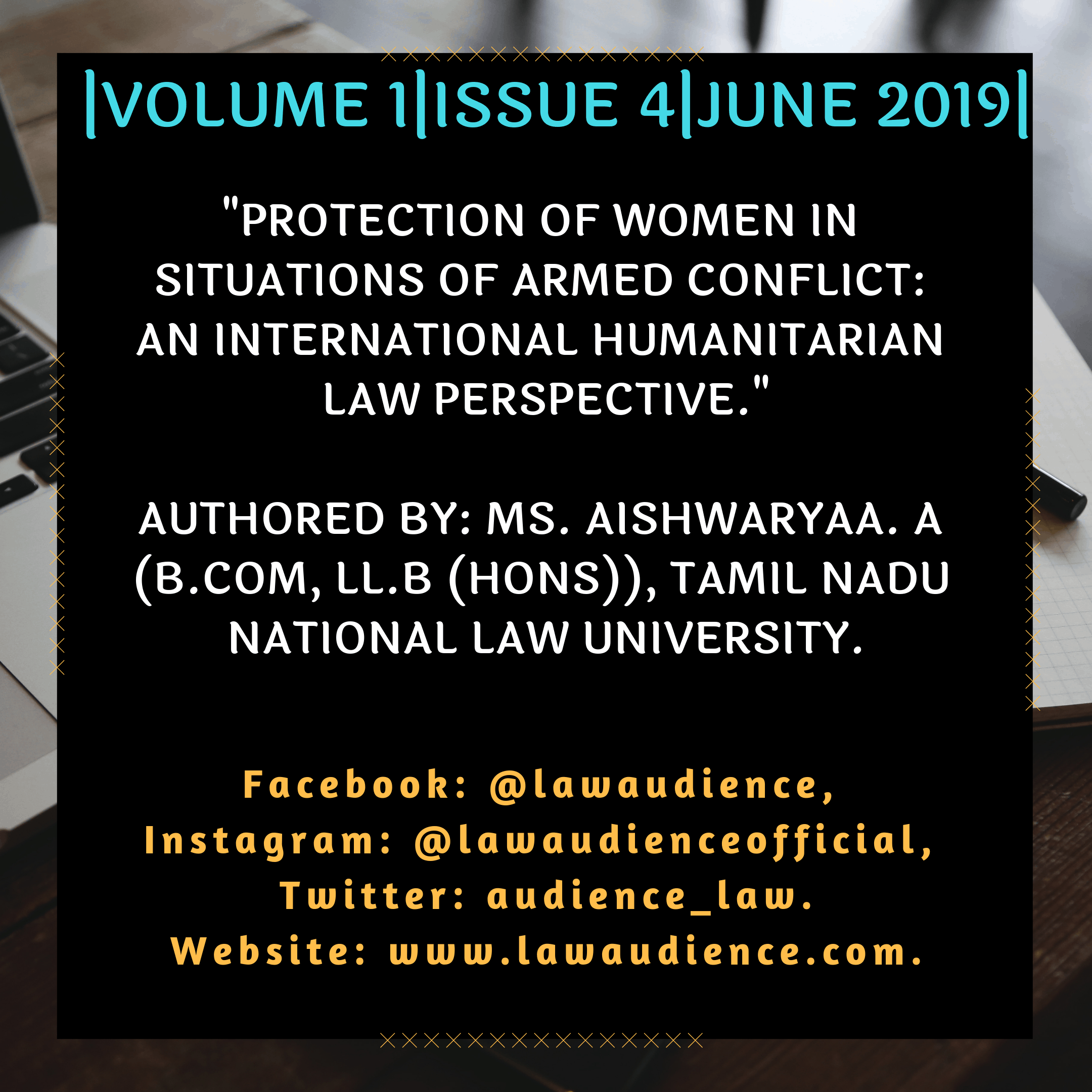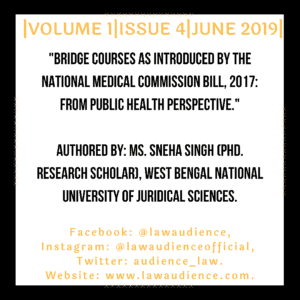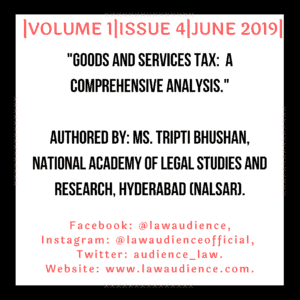Authored By: Ms. Aishwaryaa. A (B.Com, LL.B (Hons)), Tamil Nadu National Law University,
I. INTRODUCTION:
“As far as armed conflict is concerned, women are on the side of bearing the brunt of the burden imposed upon them. In recent years, the question of vital importance has been thrown towards the question of violence against women in armed conflict. The sexual violence in the form of gender-based violence is one of the main weapons used by warfare and it is one of the characteristics of contemporary armed conflict. In furtherance to this, it is seen that women not only face crimes like rape but also the purposeful attempt to spread HIV and forced nudity. It is seen that sometimes the peace-keeping forces are also responsible for the gender-based violence which makes women not open up about their experience and as a result of this, the situation of women in armed conflict largely goes undocumented. This article focuses on women and their protection in armed conflict and their centrality to peacebuilding and conflict resolution. The purpose of this article is to consider a range of ways in which women are affected by armed conflict and assess the adequacy of international law in protecting them. The rules of International Humanitarian law are intended to provide protection for victims of armed conflict. For instance, The Beijing Declaration for Platform Action. This regime has been criticised as inadequate in performing its task in modern-day armed-conflict. It is unequivocal that its provisions operate in a discriminatory fashion in relation to women.”
II. WOMEN’S EXPERIENCE IN ARMED CONFLICT:
Armed conflict is the time in which the women generally face struggle as a civilian but this aspect need not always be negative in the sense that it can be seen as a way of empowerment wherein women do step into the shoes of men. The numbers of female combatants are many in numbers as far as an armed struggle is concerned[1]. The subservient position of women in reiterated even in the case of military institutions[2]. There is a vast difference as far as the environment of both female and male combatants are considered. It is true that the third Geneva Convention provides for better facilities in case of reproductive health by way of a better environment in prison[3]. There are various economic problems that women particularly face in situations of armed conflict. The lack of income from their male counterparts is one such issue. Women in such situation often see themselves to have vital characteristics of education; training missing and their attitudes generally make it hard for them to survive financially. The resources get diverted in situations of armed conflict and therefore are majorly disadvantaged. As far as the health of the female is concerned, it is seen that women are more prone to malnutrition due to the existence of cultural norms. Patriarchy in society mandates for the men to eat first and not the women under any circumstances. The sanctions imposed on Iraq after the Persian Gulf-War elucidates this phenomenon[4]. As far as the aids from any institutions are concerned, it almost always fails to reach the women survivors. Men are placed in a higher pedestal as they take in charge of the distribution process relating to humanitarian assistance even though it’s the women who are generally having an inherent character in them when it comes to food preparation and distribution.
In the same, men and women dealing with physical violence is a detriment to whether the women’s experiences are opened up. Usually, sexual violence against women are not discovered by fact-finding institutions. Only nine months after genocide, when the event of women giving birth in humongous numbers happened, the UN fact-finding mission in Rwanda systematic sexual violence against women documented the same. This proves the fact that women usually tend to not discuss their ordeal as far as sexual abuse is concerned which makes it highly difficult to provide help to this effect, women reporters and investigators make a huge difference when it comes to making the survivors open up according to the Human Rights Watch[5]. The peacekeepers also contribute to the rising number of sexual abuse. In Cambodia, according to the various reports, there was sexual abuse not just by the parties to the situation of armed conflict but also the UN peacekeepers. These events bring up the disputed issues of whether the provisions of International Humanitarian Law are binding on the United Nations. A broad approach with respect to the provisions and applicable law is urged by the The International Committee of the Red Cross (ICRC) when it comes to UN contingents while resorting to either peace enforcement or peacekeeping strategies. Although, the fundamentals and rules of International Humanitarian law are only applicable to the United Nations.
There are various factors which contribute to the aftermath of an armed conflict as far as women are concerned. These facts are questions whether these survivors are civilians or combatants and whether they are homeless and as well as the factors such as health, circumstances relating to their daily situation, class, race, social identity, employment and sexuality. Some common experiences are possible to be described[6]. Recently, the outbreak of sexual violence has been reported in various countries like Iraq, Syria, Afghanistan, Burundi, Chad, Columbia, Côte D’Ivoire, Democratic Republic of the Congo (DRC), Liberia, Peru, Rwanda, Sierra Leone, Chechnya/Russian Federation, Darfur, Sudan, Northern Uganda, and the former Yugoslavia[7].
III. HOW INTERNATIONAL LAW RESPONDS TO WOMEN AND ARMED CONFLICT:
It is through International Humanitarian Law (IHL) the wounded, the sick, the prisoners of war and the civilians in the hand of enemies are being protected. Forty-three provisions of the Geneva Conventions and protocols specifically deal with women and the effect of armed conflict. However, they all deal with women in their relationship with others, not as individuals in their own right.
Since 2000, the development of normative standards owes to the Security Council which is an important forum for women in situations of armed conflict. In October 2000, the resolution 1325[8] was adopted to address the issue of the protection of women in armed conflict. The Security Council launched the theme of Women, Peace and security. This resolution was inclusive of women as participants in the peace process to make a gender conducive[9] environment when it can to promote peace in conflicted areas. The primary objective was for the greater participation of women in peace and in all stages of armed conflict ranging from prevention, management and resolution.[10] Secondly, as far as the post-conflict situation and restoring of the state is concerned, a gender perspective step was considered to take into account the special needs of women. In this process men were only considered for the disarmament were they were asked to take into account the different needs of male and female ex-combatants.
Most importantly, the resolution asked for the protection of women and girls from excruciating events such as sexual abuse especially rape by complying with the existing international humanitarian and human rights law. In the end, the resolution made an attempt to have an analysis or study on the implications of armed conflict on women and girls and the importance of women representation in post-conflict situations. Security Council Resolution 1325 is considered to be extremely significant and groundbreaking in the sense that it was the first time ever that the issues relating to women were addressed by the Security Council as it set a high bar for the United Nation Institution as a whole. The United Nations Development Fund for Women (UNIFEM) and governments such as Nambia and Bangladesh have done significant activism and the birth of the resolution is a product of such activism by women’s group. Although the primary responsibility of the Security Council did bring under its ambit the women’s security[11], the resolution 1325 was not incorporated in Chapter VII of the UN Charter and therefore there is no legal recourse in the UN Member states as they are not bound by it. The institutional activity has been taken up because of this move which resulted in many policies, guidelines and training programs which were launched by the United Nations[12]. In the year 2007 and inter-agency forum was created by the United Nations. As a result of this forum, the United Nations action against sexual violence in the conflict did bring together around thirteen agencies which were vital to initiate a guide on advocacy, training, sharing knowledge regarding the sexual violence that women face during armed conflict. Another attempt by the Security Council is that they annually held debated and Arria meetings to discuss women and the solution to their struggles. The resolution 1325 was reported in the Secretary-General’s 2004 report which is in the form of a transnational justice. The member states have taken a step ahead by incorporating the same in their national strategies and policies. This resolution has been used by women organisations to demand justice in the form of the disarmament process. Although this revolution has seen the light in national pans and has initiated international attempts in peace and security, the Secretary-general in 2004 stated that these actions fall far behind reality.
Another attempt was made in the form of Resolution 2122 which was a groundbreaking move and was adopted by the Security Council on 18 October 2013. It begins with a pedigree and reconfirming the previous six resolutions adopted by the Security Council which dealt with peace and security. It talks about the Beijing Declaration for the platform of action and the objectives undertaken by them especially in eliminating all forms of discrimination that women face[13] followed by its Optional Protocol of 2000. The issues identified by the resolution 1325 have been addressed in resolution 2122 rather than just concentrating on women’s participation in the peacemaking process. The reason behind framing this resolution owes to the reason that there were various loopholes and there were inherent problems in implementation as far as the security agenda is concerned.[14]
These gaps are inherent in the physical abuse and also the act that were are minimal chances for women to take on the leadership role in the post-conflict process, and the commitment to all objectives of 1325.
In the recent issue of Yazidi Women and children, The United Nations Human Rights Council mandated a summit on Addressing Large Movements of Refugees d Migrants to record and investigate all violations of International Law in Syria.
According to the Report of “They came to destroy: ISIS Crimes against the Yazidis”, ISIS has sought to kill the Yazidis, The kind of torture inflicted upon them results in slow deaths, forced conversion of adults and transfer results in bodily and mental harm. They even engage in practices which results in Yazidi Children not being born.
Resolution 2122 is a biter attempt in comparison to the previous resolution adopted by the Security Council since they provide for substantive improvements. It reaffirms the empowerment of girls and women to provide for gender equality in the arena of international security and peace and provides for the dedication and handwork that it required. The mandates of UN Mission must provide for promoting gender equality and empowering women, and provide for participation and protection as far as disarmament, political process and other objectives of the mission are concerned. This obligation is bound to be complied by member-states who are in the stage of the post-conflict process. The earlier resolutions are consolidated by way of fleeting references.
IV. THE INADEQUACY OF PROTECTION:
When contentions as to the adequacy of these International provisions are concerned, it is usually stated that the provisions and objectives are sufficed by it’s the implementation that takes a back seat. It is true that better implementation is needed but what cannot be disputed is the fact that these rules, objectives are inherently discriminatory. The fundamental flaw cannot be solved despite whatever the implantation is[15].
Women are not considered as individuals in their own right as far as International Humanitarian Law is concerned. Men are always held in a higher pedestal and their experiences are always taken to be the starting point. We live in a world were there in inherent discrimination everywhere between both the sexes and taking into account just the experience of men would not be right as a response to armed conflict situations. It is true that women and men suffer in different ways as far as armed conflict is considered. The laws which are framed with just men in mind would be against principles of natural justice. Although as already discussed International Humanitarian Law does provide for special laws for women, it is inadequate in the sense that it refers to women who are pregnant or if they are prisoners of war. The male perspective in the given rule is that they are viewed only as sexual and reproductive organism.
To discuss the sanctions of International Humanitarian Law, there is a significant increase in the random impact with which it can be operated. The implications of this are often different and unnoticed[16]. On many recent events, these sanctions have been seen to be associated with the Security Council as a pertinent element for a solution in armed conflict. The direct implication of this sanction on various states has been recorded. The Persian Gulf conflict illustrated the particular implications wherein the measures taken by way of sanctions continue to date even after the cessation of armed hostilities.
There are various branches of International Humanitarian Law that regulate the sanctions of international humanitarian law. Some provisions of the International Humanitarian Law are pertinent to be discussed. Firstly under Articles 54, of Protocol I and 14 of Protocol II starvation cannot be used as a method of warfare this provision prohibits it. Reliefs in certain circumstances are provided under Article 70 of Protocol I. In furtherance to this The Fourth Geneva convention imposes a certain obligation by virtue of Article 23 and 55 in relation to the providing the essential commodities to civilians by the occupying state of contracting powers. But the inadequacy arises since these rules apply only when there is a conflict in the process whereas in the case of the fourth Geneva convention only when there is an occupation. As far as a post-conflict is concerned, there is no relevant law applicable[17].
Iraq is facing economic sanctions till date which forms the solution to the threat that is imposed by the state to the international peace and security. This is outside the scope of any rules formulated for armed conflict situations. These sanctions are imposed by virtue of the powers exercised by the Security Council under Chapter VII of the United Nations charter[18]. The mandatory obligations on the part of states are imposed by the Security Council under Chapter VII. By virtue of article 103 of the charter, the obligations prescribed under chapter VII takes precedence over any other treaty even those of International Humanitarian Law. Moreover, there is a pressing question if the Security Council would be bound by any limitations that the International Humanitarian Law.
V. CONCLUSION:
From the article, it can be comprehended that women and children are the most vulnerable when it comes to situations of armed conflict. There are inherent issues such as the discrimination that women face in armed conflict which poses hindrances to them in getting supplies at times of need. As far as a bigger picture of gender violence is concerned, women participation as investigators is necessary so as to take remedial measures and document the trauma that victims have faced. The United Nations have taken major attempts by passing resolutions specifically for women in situations of armed conflict. More recently it is seen that the attempts that are taken towards the protection of women in armed conflict are extensively increasing. There are obvious hindrances in achieving these objectives just like any other branch of International humanitarian law. It is true that major changes are taking relating to women in international humanitarian law, but despite this, they are still the most vulnerable amongst all the civilians who are suffering in the armed conflict.
The international humanitarian law does provide for a theoretical juristic framework for the protection of women from violence in armed conflict but when it comes to the implementation part, there are various obstacles. Therefore further concrete steps must be undertaken to address and protect the gender who are vulnerable to exploitation.
[1] See United Nations, Women: Victims of Violence, Advocates of Peace, in Women: CHALLENGES TO THE YEAR 2000, at 65, U.N. Sales No. E.91.1.21 (1991); Francoise Krill, The Protection of Women in International Humanitarian Law, 249 INT’L REV. RED CROSS 337 (1985).
[2] Gender-based Persecution: Report of the Expert Group Meeting, U.N. GAOR,
Division for the Advancement of Women, 52, U.N. Doc. EGM/GBP/1997/Report (1997), available on <gopher V/gopher.un.org:70/00/esc/cn6/1 998/armedcon/GBP97.EN> (visited 18 April 2019) See also CaNADIAN CENTRE FOR FOREIGN POLICY AND DEVELOPMENT, OPTIONS: REPORT ON THE ROUNDTABLE ON GENDER AND PEACE BUILDING 36 (2017) (discussing the different needs of women with regard to demobilization).
[3] See Geneva Convention(I)for the Amelioration and condition of the wounded and the Sick in Armed Forces in the field, 12 Aug 1949, 6 U.S.T 3114 , 75 U.N.T.S 31.
[4] Bela Bhatia et al., Unheard Voices: Iraqi Women on War and Sanctions, CHANGE INTERNATIONAL REPORTS: THINKBOOk VIII (2012).
[5] Anne Gallagher, Ending the Marginalization: Strategies for Incorporating Women into the United Nations Human Rights System, 19 HUM. RTS. Q. 283, 292 n.31 (2014).
[6]Margaret Urban Walker, ‘Gender and Violence in Focus: A Background for Gender Justice in Reparations’ in Ruth Rubio-Marin (ed), The Gender of Reparations (Cambridge University Press, 2009) 18.
[7] In‐depth Study on All Forms of Violence against Women: Report of the Secretary‐General, 61st sess, UN Doc A/61/122/Add.1 (6 July 2016) [145].
[8] SC Res 1325, UN SCOR, 4213th mtg, UN Doc S/RES/1325 (31 October 2000).
[9] SC Res 1325, UN SCOR, 4213th mtg, UN Doc S/RES/1325 (31 October 2000) Preamble para 8.
[10] Report of the Fourth World Conference on Women: Beijing, 4‐15 September 1995, UN Doc A/CONF.177/20/REV.1 (1996) ch I annex II (‘Platform for Action’) para 144.
[11]Charter of the United Nations art 24.
[12]Women and Peace and Security: Report of the Secretary‐General, UN Doc S/2010/498 (28 September 2010).”
[13] Convention on the Elimination of All Forms of Discrimination Against Women, 1979, 1249 UNTS 13.
[14] Optional Protocol to the Convention on the Elimination of All Forms of Discrimination against Women, 2131 UNTS 83 (entered into force 22 December 2000).
[15]Advancement of Women and Implementation of the Outcome of the Fourth World Conference on Women, Statement by the ICRC to the General Assembly 3d Comm., 53d Sess., Agenda Items 103-04 (15 Oct. 1998), available on <http://www .icrc.org/icrceng.nsf/c1 25621 2004ce24e41 25621 200524882/d366866e92d 1800141 2566a4004eb94c?OpenDocument> (visited 18 April 2019).
[16] See Sebastian Bohr, Sanctions by the United Nations Security Council and the European Community, 4 Our. J. INTL L 256 (2013).
[17] See Universal Declaration on the Eradication of Hunger and Malnutrition, adopted 17 Dec 1947
Dec. 1974, G.A. Res. 3348, U.N. GAOR, 29th Sess., UN Doc. E/Conf 65/ 20 (1974).
[18]See U.N. CHARTER art. 41, signed 26 June 1945, 59 Stat. 10 31 T.S No. 993, 3 Bevans 1153 (entered into force 24 Oct, 1945)



